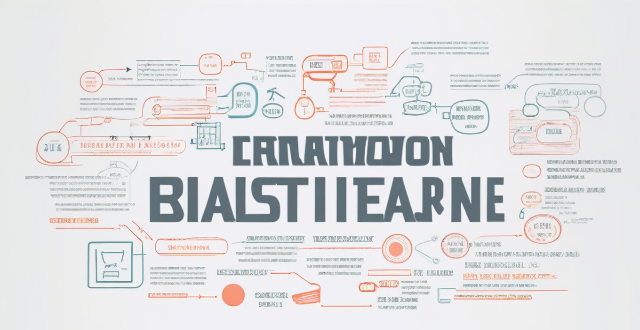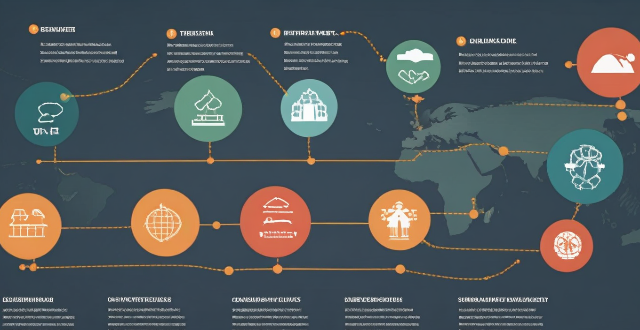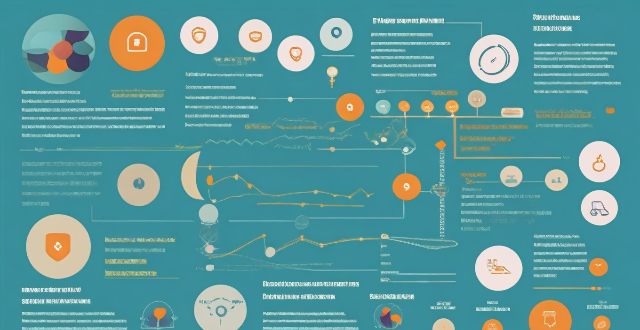Ping Stakeholder

What is the significance of ESG for stakeholder management ?
This article discusses the importance of ESG factors for stakeholder management. Environmental factors such as climate change and resource depletion, social factors such as labor practices and community relations, and governance factors such as board diversity and anti-corruption policies are all crucial for companies to consider in order to enhance their reputation, build stronger relationships with their stakeholders, and ensure the long-term viability of their operations. By incorporating ESG principles into their stakeholder management strategies, companies can demonstrate their commitment to sustainability and responsibility, which is increasingly important in today's business environment.

What is the role of public participation and stakeholder engagement in the development of climate and environmental policies ?
The article discusses the importance of public participation and stakeholder engagement in developing climate and environmental policies. It highlights that these processes enhance transparency, build consensus, provide local knowledge, identify gaps and priorities, promote equity and fairness, facilitate implementation and compliance, and promote innovation. Overall, involving a diverse range of stakeholders in the policy-making process leads to more effective, equitable, and sustainable solutions to environmental challenges.

What role do stakeholders play in shaping a company's CSR strategy ?
The text is a summary of the key points on the role of stakeholders in shaping a company's Corporate Social Responsibility (CSR) strategy. Stakeholders, including customers, employees, suppliers, shareholders, communities, government agencies, and non-governmental organizations (NGOs), are crucial in identifying and analyzing their interests, needs, and expectations. Companies need to communicate openly and regularly with their stakeholders to gather feedback and build trust. Collaboration and partnerships with stakeholders on CSR projects help achieve shared goals and strengthen relationships. Accountability and transparency are essential for companies to act responsibly and ethically. Continuous improvement is necessary based on stakeholder feedback. Risk management involves stakeholders in risk assessment and management processes. Legal and ethical obligations must be considered when developing CSR strategies. Innovation and sustainability can be driven by stakeholder input. A strong CSR strategy enhances brand reputation and loyalty. Long-term success can be ensured by involving stakeholders in shaping CSR strategy.

What is the relationship between ESG and corporate governance ?
The article explores the relationship between Environmental, SocialThe article explores the relationship between Environmental, Social (ESG) factors and It states that ESG is often considered a subset of corporate governance and focuses on specific aspects of how a company operates. Companies that prioritize ESG factors tend to have stronger corporate governance structures in place. The role of boards in overseeing a company's ESG initiatives is also discussed. Regulations and stakeholder pressure are driving the need for effective corporate governance. Best practices for integrating ESG into corporate governance include defining clear objectives, regular reviews, stakeholder engagement, and maintaining transparency and accountability.

What are the most common ESG reporting frameworks used by companies ?
The Global Reporting Initiative (GRI) is a widely used sustainability reporting framework that provides a standardized approach for companies to report on their economic, environmental, and social performance. The GRI consists of several standards, including those related to disclosure principles, management approach, economic performance, environmental performance, social performance, governance, non-financial information disclosure, reporting principles, boundaries, guidelines, content, quality, frequency, language, format, timeframe, period, entities, scope, limitations, assurance, certification, training, tools, collaboration, innovation, stakeholder engagement, data quality, impact assessment, risk management, performance indicators, materiality analysis, and stakeholder engagement process. These standards help organizations prepare high-quality GRI reports that are accurate, reliable, and consistent across different organizations and sectors.

In what ways does sports culture influence political discourse and international relations ?
The text discusses how sports culture significantly impacts political discourse and international relations. It highlights various ways this influence manifests, including promoting diplomacy and peace, fueling nationalism and identity, driving economic development, advocating for social issues, and shaping public opinion through media representation. The article also mentions specific examples such as "Ping-Pong Diplomacy," Olympic Truce, and the involvement of sports figures in peace agreements. It underscores the role of sports in cultural exchange, global marketplace activities, brand promotion, and environmental concerns. Additionally, it touches upon the use of sports for propaganda purposes, controversies like doping scandals, and their effects on international perceptions. Overall, the text emphasizes that sports culture is a potent force intertwined with global dynamics, reflecting and shaping interactions between nations.

What are the potential risks and challenges associated with implementing CSR initiatives ?
Implementing Corporate Social Responsibility (CSR) initiatives can bring benefits to a company, but also comes with potential risks and challenges. These include lack of clear goals and objectives, limited resources, stakeholder pressure, legal and regulatory issues, difficulty measuring impact, and potential backlash from stakeholders. Companies need to carefully consider these issues before committing to CSR efforts, and should work to mitigate any potential risks through careful planning and execution.

What are the best practices for businesses to report on their environmental impact as part of their CSR initiatives ?
Reporting on environmental impact is crucial for businesses as part of their CSR initiatives. Best practices include setting clear objectives and goals, collecting relevant data, analyzing environmental footprint, developing an action plan, communicating findings, encouraging stakeholder engagement, and continuously improving the reporting process. By following these steps, businesses can demonstrate their commitment to sustainability and transparency while providing valuable information to stakeholders about their environmental performance.

Is there a way to measure network latency ?
Measuring network latency is crucial for understanding a network's performance. The ping test, traceroute, and online tools are methods to measure latency. Ping tests estimate the round-trip time, while traceroute identifies bottlenecks in the network path. Online tools provide visual representations of network performance.

Are there any tools to help diagnose network latency issues ?
Network latency issues can be frustrating and detrimental to the performance of applications and services. Fortunately, there are several tools available that can help diagnose and troubleshoot these issues. Some popular tools used for network latency diagnosis include Ping, Traceroute, MTR (My Traceroute), Netstat, Tcpdump, and Wireshark. Each tool has its own strengths and weaknesses, so it's important to choose the right one based on your specific needs and circumstances. By using these tools effectively, you can identify and resolve latency problems quickly and efficiently.

Have there been any instances where sporting events have led to improved diplomatic relations ?
Sporting events have been used to improve diplomatic relations between countries, bringing people together regardless of their backgrounds or beliefs. Examples include Ping-Pong diplomacy in the 1970s between China and the US, soccer matches promoting peace in the Middle East, the Olympic Truce symbolizing goodwill and cooperation, and rugby matches representing reconciliation and forgiveness.

What is considered high network latency ?
High network latency is a delay in data transmission that can negatively affect the performance of applications and services. It is influenced by various factors such as distance, congestion, hardware performance, bandwidth limitations, QoS settings, and interference. The definition of high latency varies depending on the context, but it is generally considered to be any delay that significantly impacts the usability of applications or services. Identifying high network latency can be done using tools like ping tests or traceroute commands. Mitigating high network latency can involve upgrading hardware, increasing bandwidth, optimizing QoS settings, reducing physical distance, and minimizing interference.

Where can I enjoy haute cuisine in Hong Kong without breaking the bank ?
Hong Kong is a food lover's paradise, offering a wide range of culinary delights at various price points. Here are some budget-friendly options for enjoying haute cuisine in the city: 1. **Tim Ho Wan** - The World's Cheapest Michelin-starred Restaurant offers dim sum dishes like Baked Buns with BBQ Pork for HK$20-50 per dish. 2. **Yung Kee Restaurant** - Affordable Roast Goose is renowned for its crispy and juicy roast goose, with meals costing HK$100-200. 3. **Tai Ping Koon** - Budget-Friendly Seafood Restaurant serves fresh seafood dishes like steamed fish and shrimp with garlic for HK$50-100 per dish. 4. **Lan Fong Yuen** - No-frills Tea House with Reasonable Prices offers traditional Cantonese tea and snacks since 1956, with prices ranging from HK$20-40 per person. 5. **Kau Kee Restaurant** - Affordable Noodles and Congee is known for its beef brisket noodles and congee, with meals costing HK$30-50. 6. **Lin Heung Kuttay** - Cheap and Cheerful Desserts specializes in traditional Chinese desserts like mango pomelo sago soup and durian pudding, with prices ranging from HK$10-30 per dessert. These options prove that you don't have to spend a fortune to enjoy delicious food in Hong Kong.

Is it possible for sports to transcend political differences and bring nations together ?
The article discusses the potential of sports to transcend political differences and bring nations together. It highlights three key ways in which sports can achieve this: through competition, cultural exchange, and diplomacy. The power of sports is demonstrated through various examples, such as the Olympics, World Cup, NBA, Formula One, Ping-Pong Diplomacy, and Peace Games. The article concludes that while political conflicts may still exist outside of sports, these activities provide a platform for positive interactions and collaboration that can lead to lasting change.

What are the benefits of conducting a climate risk assessment ?
Conducting a climate risk assessment is crucial for understanding the potential impacts of climate change on operations and assets. It offers benefits such as improved decision-making, identification of vulnerabilities and opportunities, better planning and management, alignment with regulatory requirements, and enhanced reputation and stakeholder engagement.

How can companies effectively implement CSR initiatives ?
Companies can effectively implement CSR initiatives by defining clear objectives, conducting a stakeholder analysis, developing a CSR strategy, integrating CSR into business operations, communicating CSR initiatives, collaborating with partners, and evaluating and improving CSR initiatives regularly. This helps companies build a good reputation, attract customers, and improve employee satisfaction.

How can we improve road safety in our community ?
Road safety is a crucial aspect that requires collective efforts from all stakeholders. Here are some ways to enhance road safety: education and awareness, infrastructure improvements, enforcement of laws, technological advancements, community involvement, and collaboration with stakeholders. By implementing these strategies, we can create a safer environment for everyone.

How does TCFD align with other global reporting initiatives like the Global Reporting Initiative (GRI) ?
The Task Force on Climate-related Financial Disclosures (TCFD) and the Global Reporting Initiative (GRI) are two global sustainability reporting frameworks that share several key points of alignment. Both provide guidelines for companies to report on their sustainability performance, with TCFD focusing specifically on climate-related financial disclosures and GRI covering a broader range of sustainability issues. They also emphasize the importance of materiality assessment, stakeholder engagement, risk management, and climate change disclosures in determining which aspects are most relevant to an organization's business model and strategy. By following both frameworks, companies can provide a more comprehensive picture of their sustainability performance and demonstrate their commitment to addressing climate change and other sustainability issues.

How can we ensure that climate action initiatives are equitable and just ?
To ensure that climate action initiatives are equitable and just, it is important to prioritize vulnerable communities, promote participatory decision-making, address historical responsibility, ensure transparency and accountability, and foster multi-stakeholder collaboration. This approach can help create a more resilient world where everyone has the opportunity to thrive despite the challenges posed by climate change.

What challenges do companies face while implementing TCFD disclosures ?
The text discusses the challenges that companies face in implementing TCFD disclosures. These challenges include data availability and quality, technical expertise and capacity, regulatory and legal requirements, stakeholder engagement and communications, and integrating TCFD into business strategies. Companies need to address these challenges by building capacity, improving standards, and enhancing transparency around climate-related risks and opportunities.

How do investors evaluate a company's CSR performance related to climate change when making investment decisions ?
When making investment decisions, investors consider a company'When making investment decisions, investors consider a company' Responsibility (C investors consider a company's Corporate Social Responsibility (CSR) performance related to climate change. The article discusses how investors evaluate a company's CSR performance related to climate change when making investment decisions. The first step in evaluating a company's CSR performance related to climate change is to assess its environmental impact. Investors look at the company's carbon footprint, energy consumption, waste management practices, and other environmental metrics to determine its impact on the environment. Companies with lower carbon emissions and better waste management practices are considered more sustainable and attractive to investors. Investors also evaluate a company's sustainability reporting practices. Companies that provide detailed reports on their environmental impact, social responsibility initiatives, and governance practices are seen as more transparent and accountable. Another important factor that investors consider is a company's use of renewable energy sources. Companies that rely heavily on fossil fuels for their operations are considered less sustainable than those that use renewable energy sources such as solar or wind power. Carbon offsetting programs are another way that companies can demonstrate their commitment to reducing their carbon footprint. Finally, investors evaluate a company's stakeholder engagement practices related to climate change.

How can we involve community members in climate adaptation planning ?
Community engagement is crucial for successful climate adaptation planning. To involve community members, identify and engage stakeholders, develop a stakeholder engagement plan, use multiple channels of communication, involve community members in decision making, provide training and education, foster partnerships and collaboration, and monitor and evaluate progress. By doing so, you can create a more resilient community that is better prepared for the impacts of climate change.

How do we measure the success of a climate policy ?
Measuring the success of climate policies involves monitoring key indicators such as reductions in greenhouse gas emissions, shifts in energy consumption patterns, changes in deforestation rates, and increased public awareness and participation. Methods of evaluation include data collection and analysis, comparative studies, modeling and projections, and stakeholder feedback. A combination of quantitative and qualitative assessments is necessary for a comprehensive understanding of policy impacts, ensuring that climate policies consider environmental, social, and economic factors for sustainable and equitable outcomes.

What are the most effective strategies for implementing climate decisions ?
Effective strategies for implementing climate decisions include developing a clear vision and goals, building a multi-stakeholder coalition, creating an action plan, implementing policies and regulations, fostering innovation and technology development, engaging the public and building consensus, and monitoring progress. These steps require careful planning, collaboration, and ongoing evaluation to address the urgent challenge of climate change and create a more sustainable future for all.

How do you measure the success of a sports marketing campaign ?
Measuring the success of a sports marketing campaign is crucial. Metrics include increased brand awareness, improved sales and revenue, customer loyalty, enhanced brand image, media coverage, sponsorship value, and positive stakeholder feedback. These metrics provide insights for adjusting strategies.

How does TCFD differ from other sustainability reporting frameworks ?
The Task Force on Climate-related Financial Disclosures (TCFD) is a unique sustainability reporting framework that focuses specifically on the financial risks and opportunities associated with climate change. It differs from other frameworks such as the Global Reporting Initiative (GRI) and the Sustainability Accounting Standards Board (SASB) in several key ways, including its exclusive focus on climate change, emphasis on financial implications, stakeholder engagement, specific recommendations for reporting, and integration with financial reporting. TCFD's approach helps companies effectively communicate their climate-related financial risks and opportunities, making it a valuable tool for navigating the complexities of climate change and its potential impact on their bottom line.